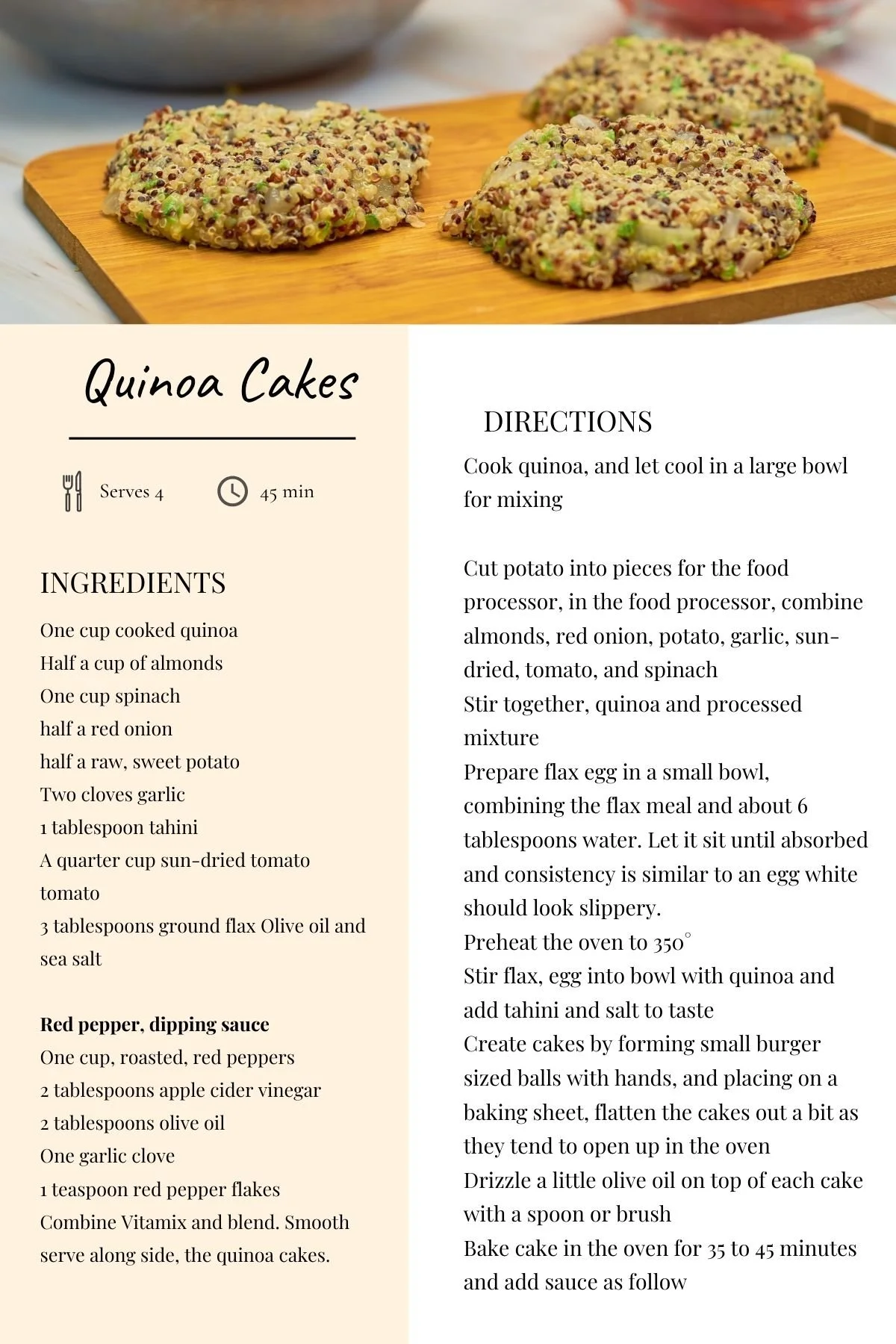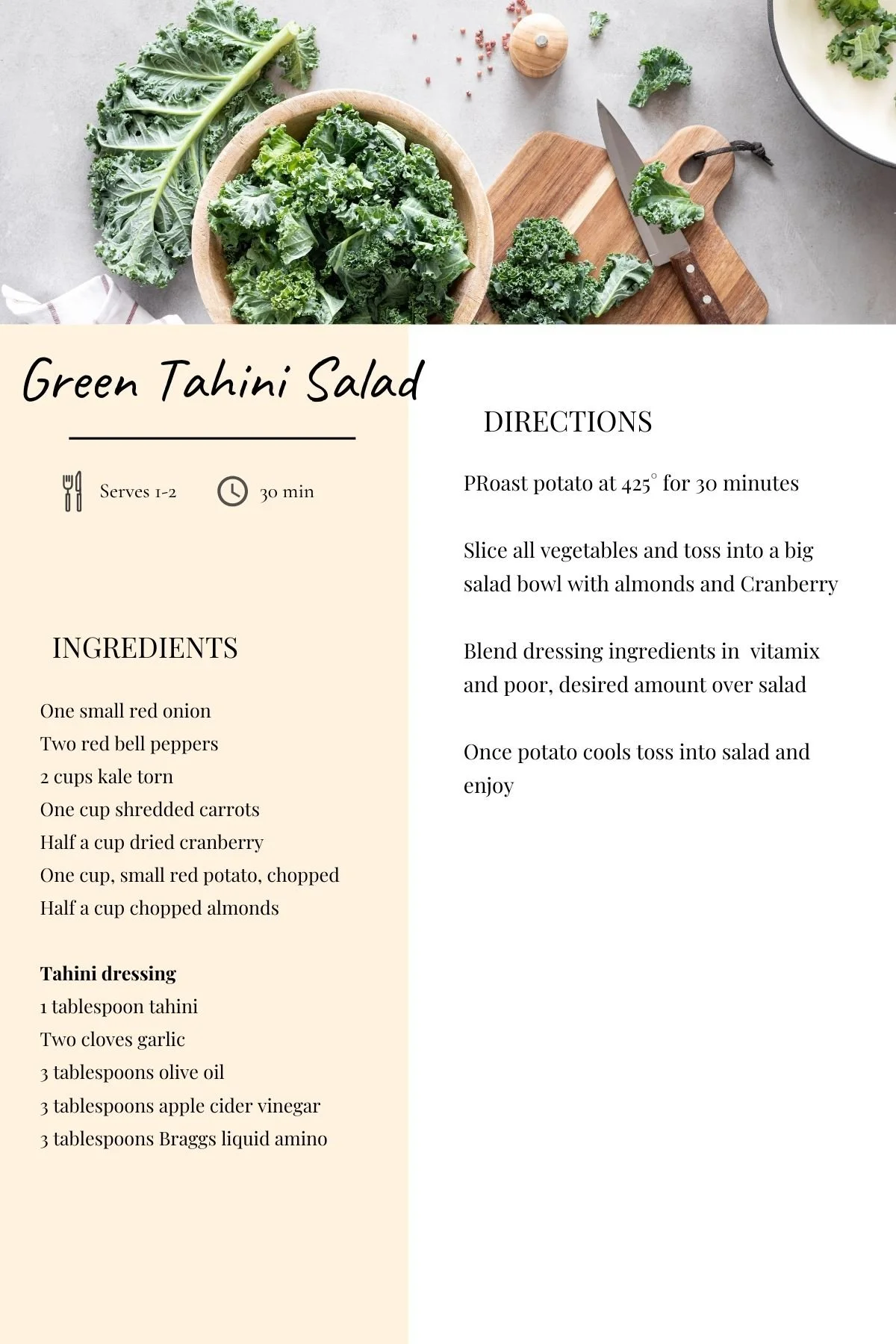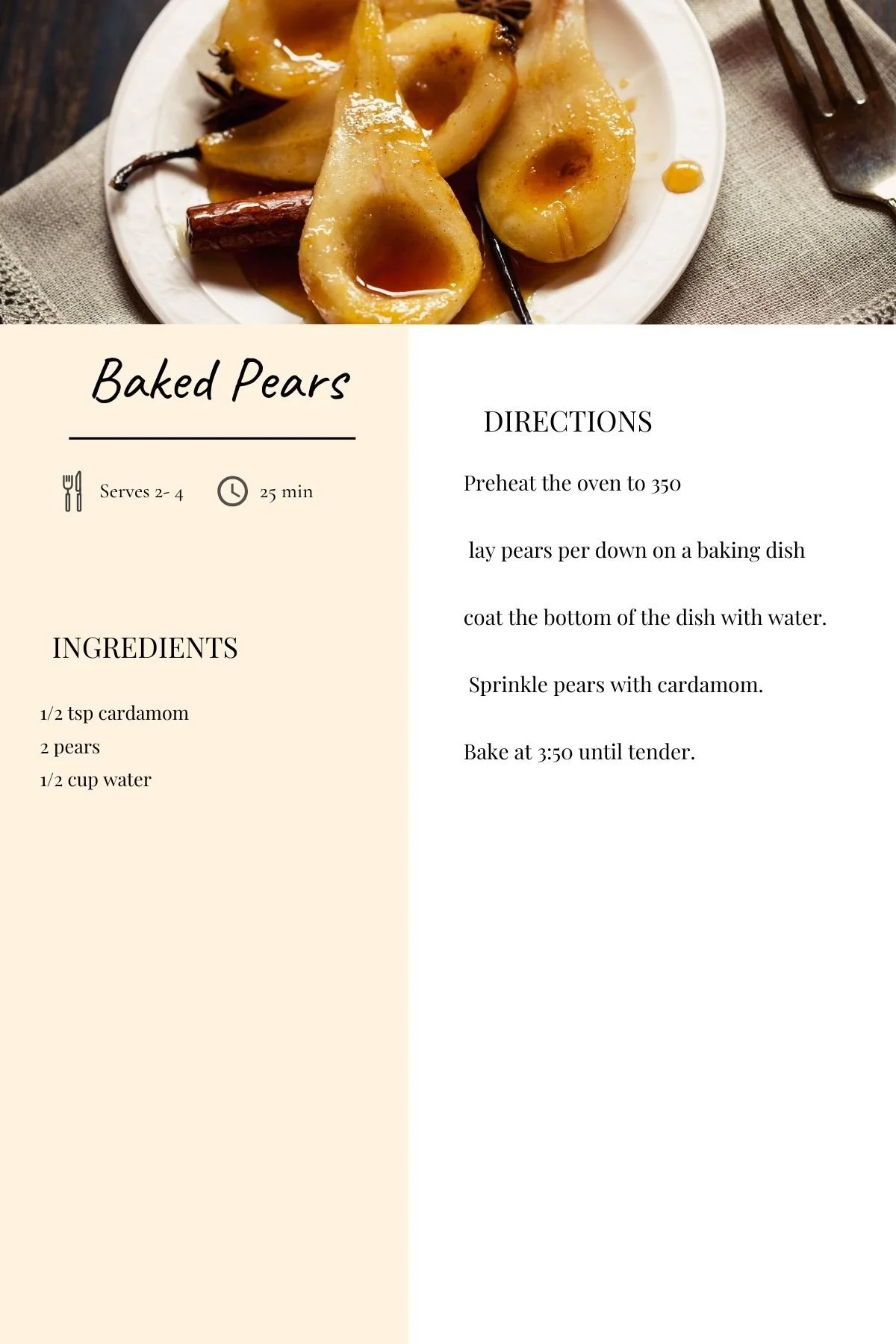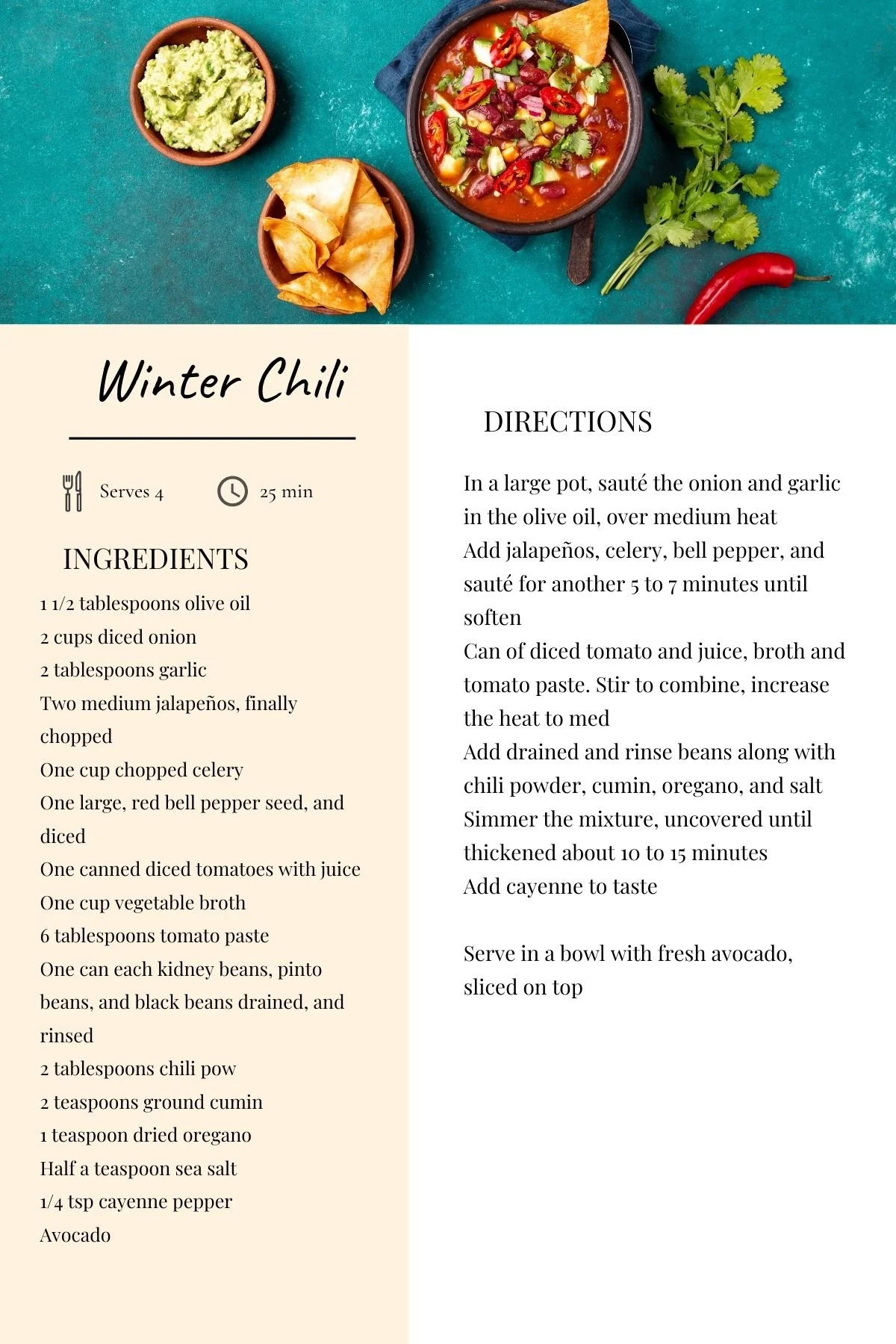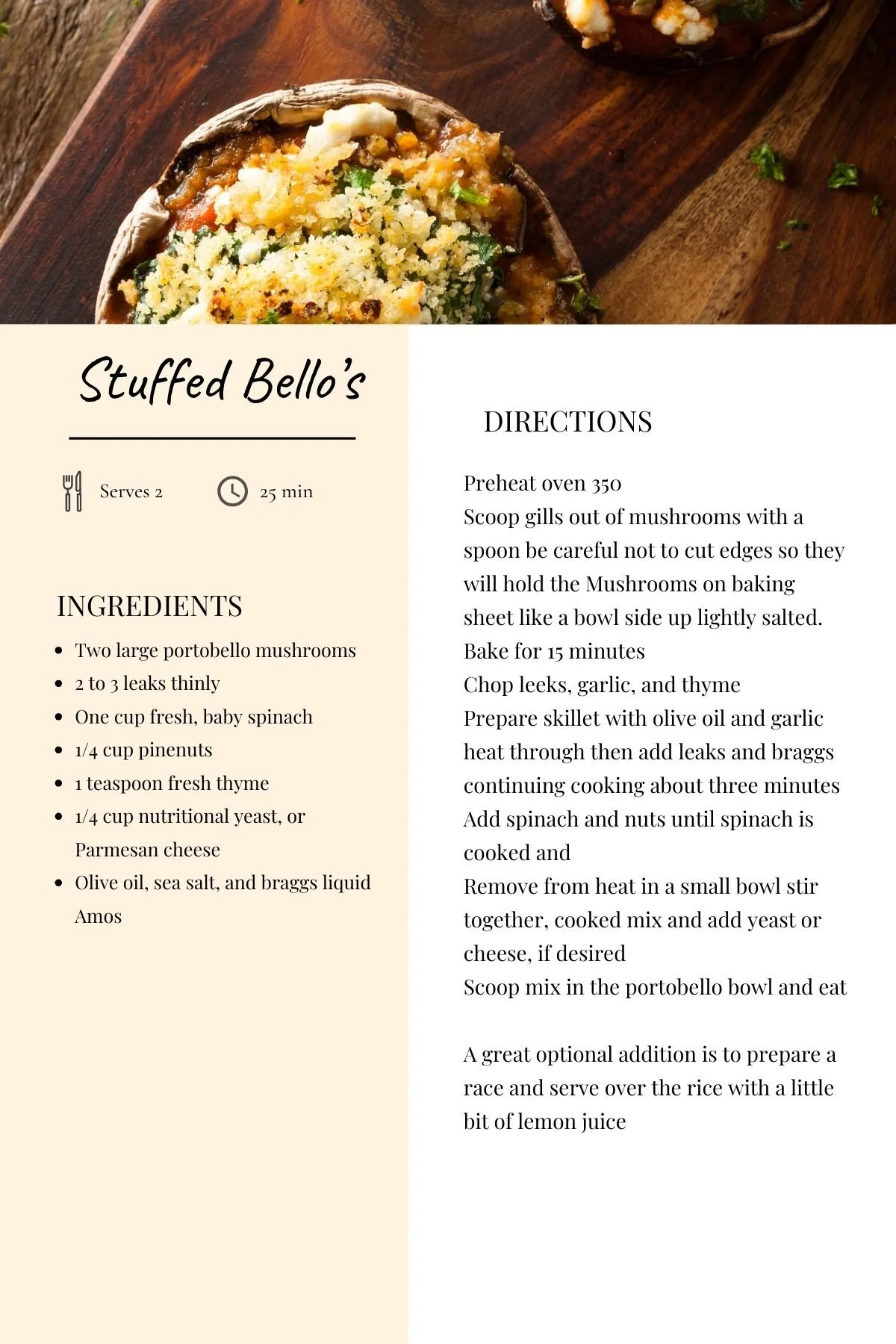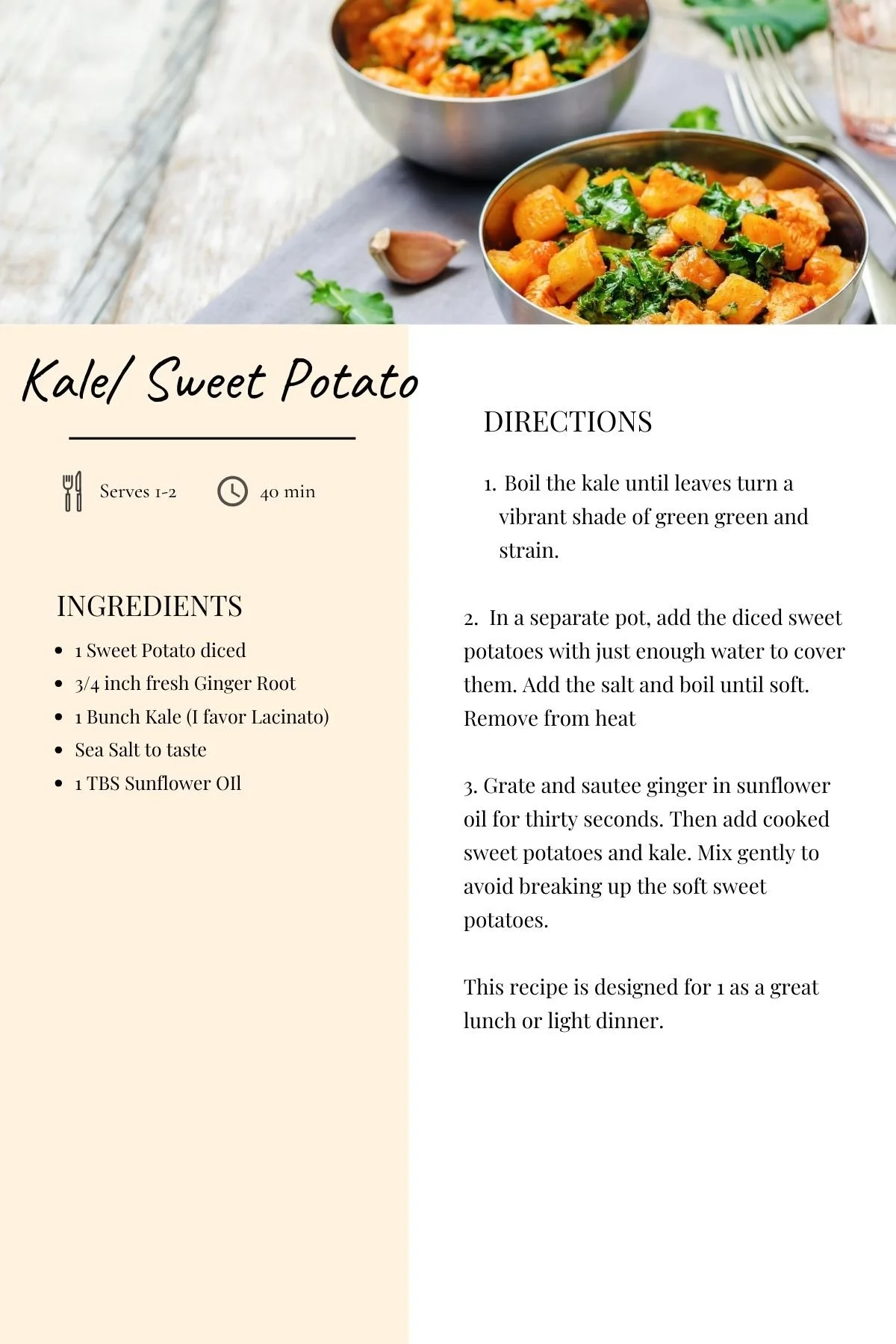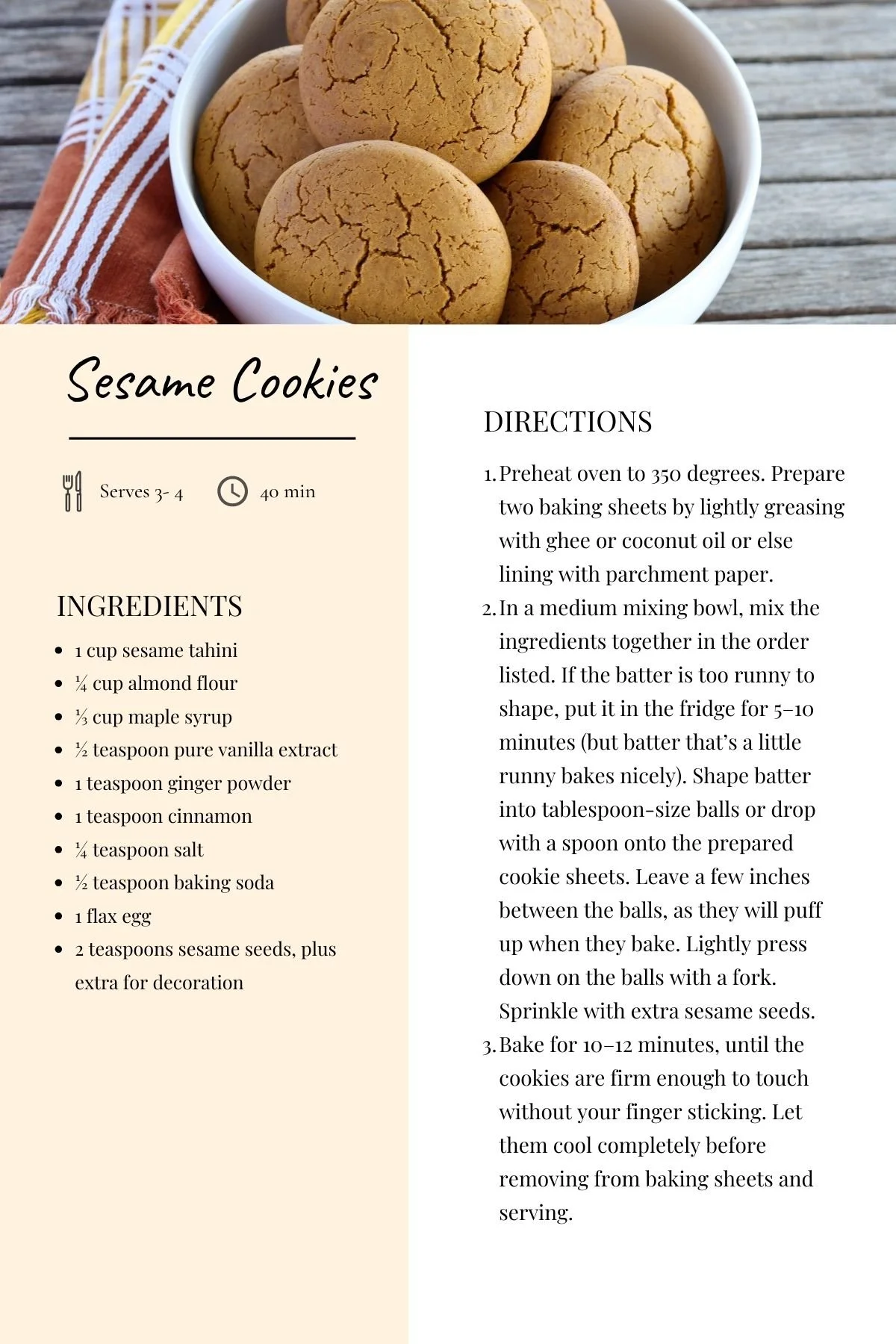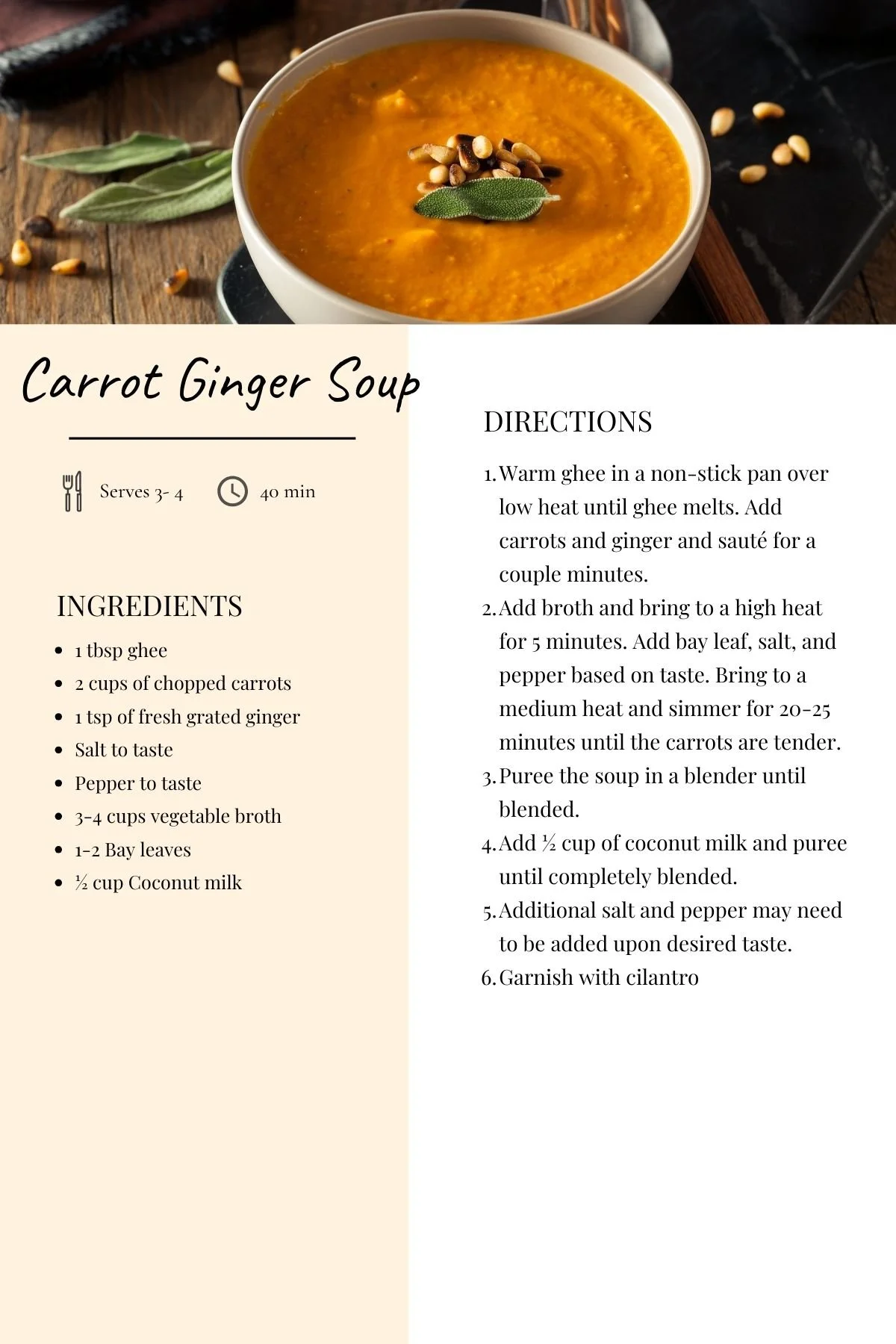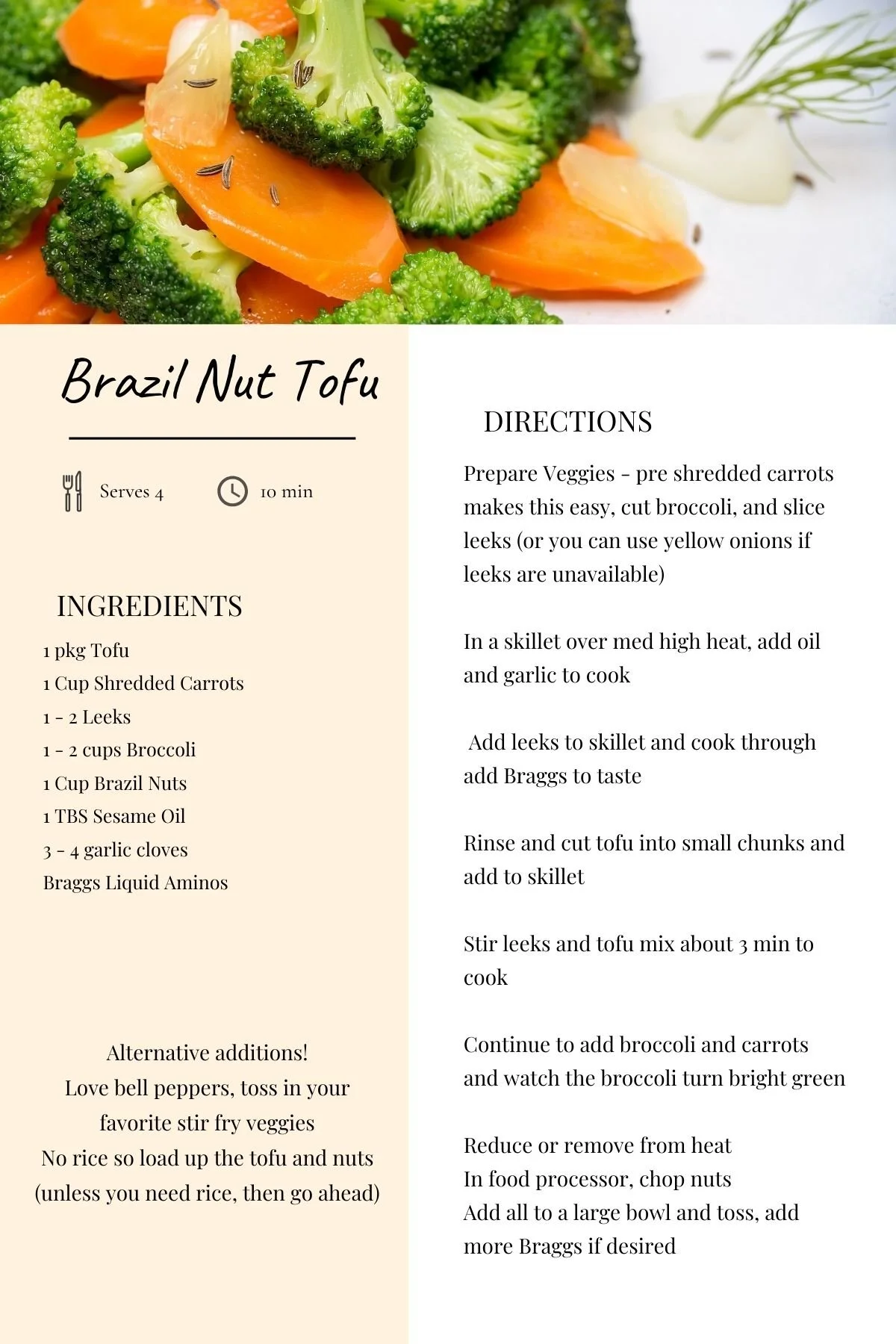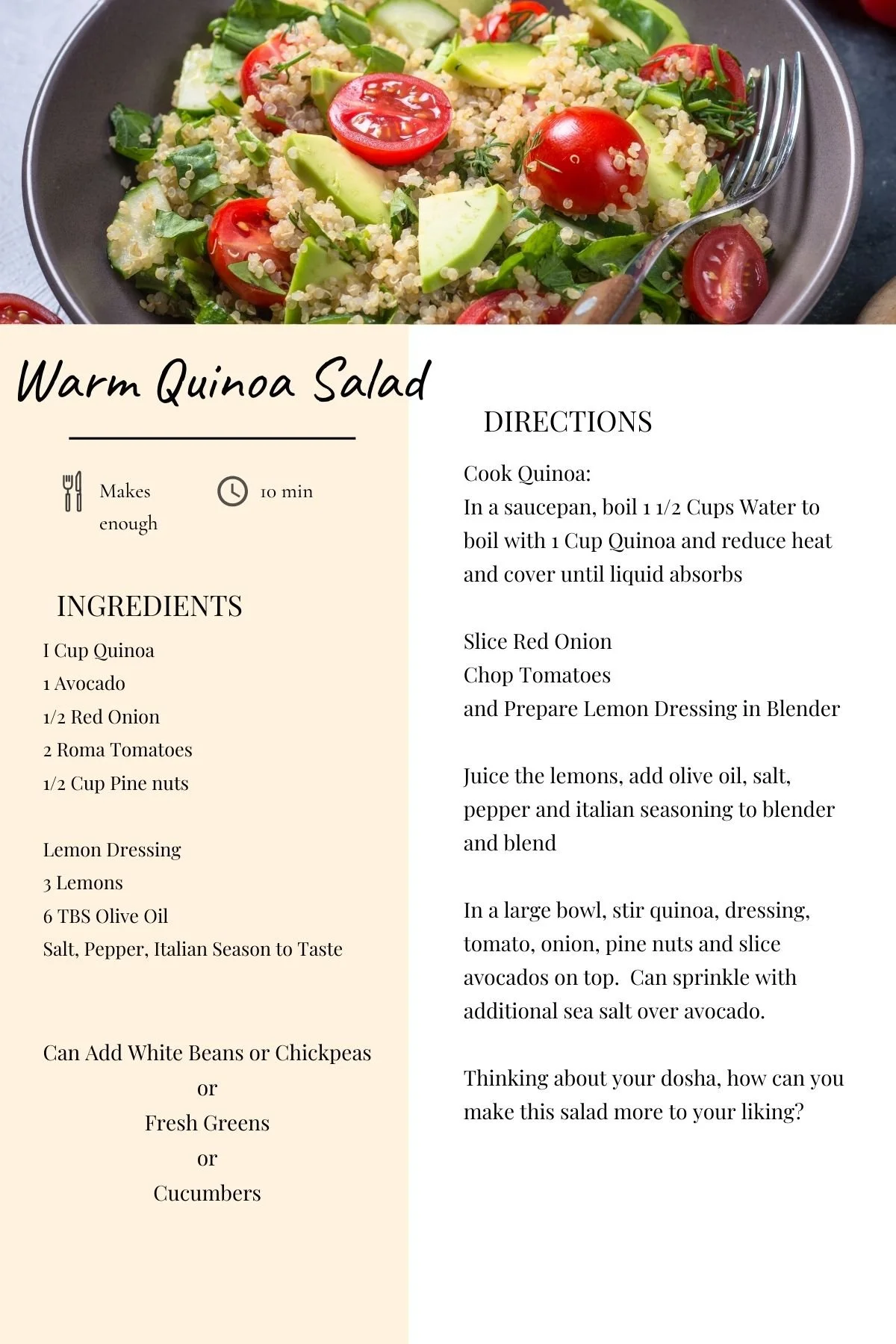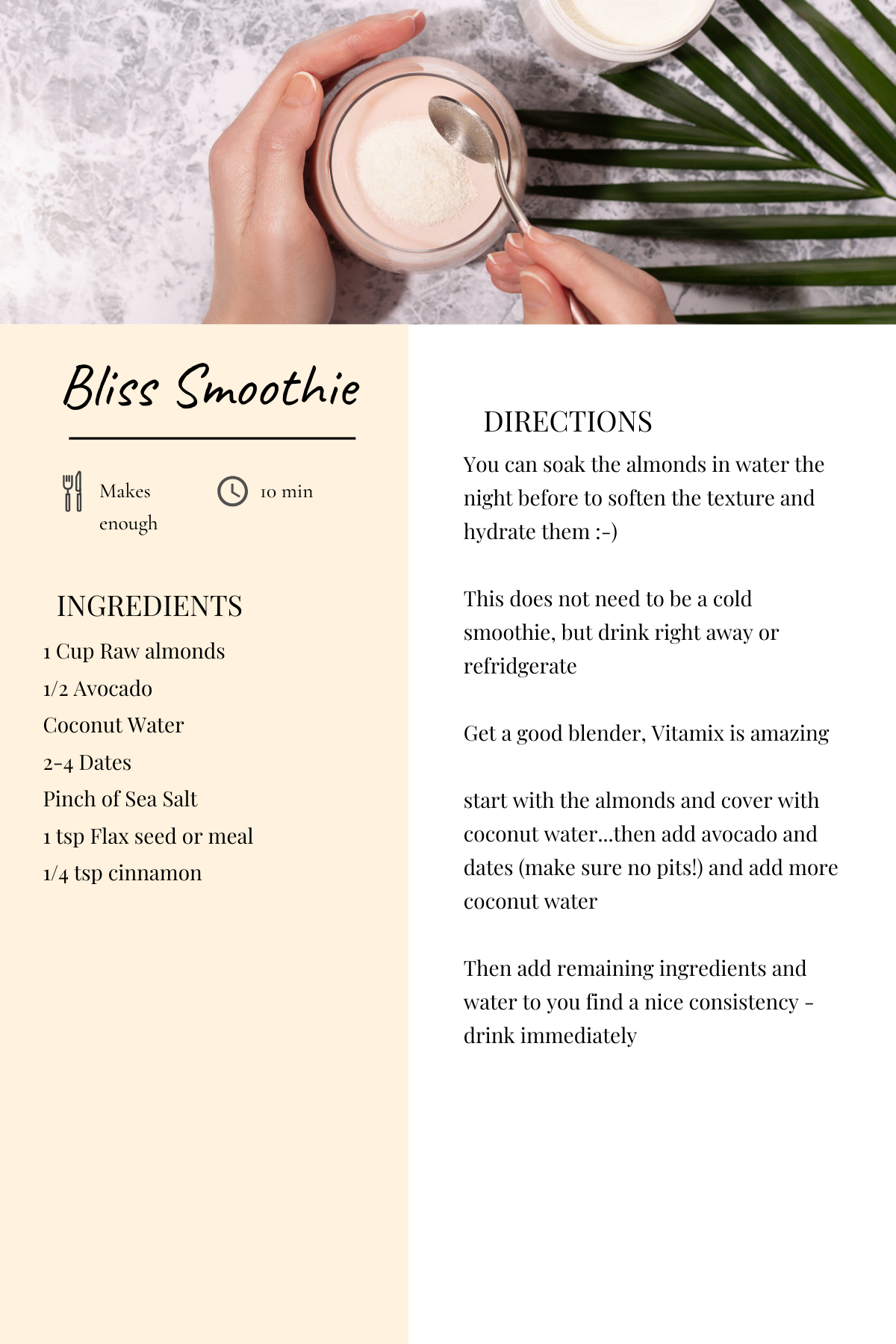Quinoa Cakes
This one may take some time. I have prepared these cakes for parties and even had them in part of a catering to events back in San Diego. They really are worth it - the part you want to watch is the end consistancy before patting out into a cake, make sure they are not too big and you’ve got enough flax egg to squeeze together. After baking they should have a nice crispy outside.
Roast Tomato Pesto
Pasta can be so good! I love pasta as a base for different flavors, sauces, vegetables etc. But its got such a bad rap when everyone went gluten free or freaked out about carbs. I think, better to have loads of wonderful ingredients that taste amazing and are also healthy, and allow the pasta to be enjoyed. Now there are gluten free options if that’s better for you, or you can even grab a zucchini and break out the spiralizer to whirl up some long veggie noodles.
Green Tahini Salad
I love a salad that can be warm and nutty! This one was one of our favorites from when we had our “Meal delivery” its a meal kind of salad, with crunch and zing from the cranberry, almonds and yummy dressing
Aromatherapy
Imagine the scent of fresh-roasted coffee seeping from the kitchen, a bouquet of roses lifted to your nose, or the smell of spring rain as you step outside at dawn. Pleasant scents can lift our mood, spark memories, and improve our cognition, while unpleasant ones can cloud our minds or make us sick. Why? Because there is a direct link between our sense of smell and a part of the brain called the limbic system—the structure of basic instincts that sparks our emotions and memories.
Use aromas to invoke states of well-being of a particular emotional state is known as neuroassociative conditioning, a technique that can be used to increase our bodies healing response and activate our in our pharmacy. For example, if each time we sit to meditate, we use a sandalwood fragrance, we will soon learn to associate the feeling of relaxation with the aroma at other times simply smelly in the fragrance will trigger a sense of quiet, relaxation. (BTW that is the inscence I burn in the M8 studio!)
In order to benefit from the healing effects of aromatherapy, identify an aroma that you are especially fond of and deeply inhale the essence whenever you are feeling relaxed, at peace, or are having a particularly good day. Gradually your body will associate the pleasurable feelings with the use of the aroma before just the smell of the essence will evoke a heightened state of well-being.
If you’re interested in experimenting with aromatherapy on your own, remember that the scents that appeal to you are probably good for you.Certain fragrances can be used to pacify imbalances in the mind and body. Restlessness, anxiety, cramps, backache, heart, palpitations and anxiety are imbalances of the air principal and may be relieved with floral, fruity, warm, sweet and sour smells found in basil, orange vanilla, and geranium. Fire disorders like anger, impatience jealousy, or hyper acidity can be soothed to a sweet and cooling fragrances like sandalwood Rose and Jazmin. Disorders of the earth principal usually manifest as laziness, drowsiness, or retention of fat and fluid, and can be stimulated back into balance with the use of spicy heating smells like eucalyptus, musk, camper, juniper, or clove.
Aromatherapy can be used in a variety of ways senses are formulated to be applied directly to the skin like a perfume, but others are intended to be diffused in the air fill in your home and office with pleasing smells, will help to balance your physiology, and may even have a positive influence on your visitors
MOOD OILS
Here are a few sample recipes you can try at home. Massage one of the mixtures on your pulse or add it to any ayurvedic treatment that calls for essential oil. You can also omit the oil base and put a mixture into an aromatherapy diffuser or a hot bath.
Calming and warming (relieves anxiety; balances vata) 3 drops each neroli & lemon + 2 drops each jasmine & sandalwood + 1 drop vanilla + 1 oz. pure jojoba oil base
Calming and cooling (relieves anger; balances pitta) 5 drops each sandalwood & vetiver + 1 drop jasmine + 1 oz. pure jojoba oil base
Stimulating (relieves depression; balances kapha) 4 drops bergamot + 3 drops each lavendar & basil + 1 oz. pure jojoba oil base
Sedating (relieves insomnia; balances vata & pitta) 6 drops rose + 2 drops each jasmine & chamomile + 1 oz. pure jojoba oil base
Grounding and strengthening (relieves fear; balances vata) 4 drops patchouli + 2 drops each sandalwood & cardamom + 1 oz. pure jojoba oil base —Pratima Raichur, Ayurvedic Beauty Care
Visual Meditation
Choose to focus on healthy images. The image is that enter through our eyes, have a profound effect on the body, mind and emotions. While gazing at a beautiful sunset, we generate, soothing, pleasurable chemicals. On the other hand, watching a violent movie, triggers, the release of stress hormones, which flood our circulation agitating every cell in our body. Studies have shown that people staying in the hospital after surgery, recover more rapidly, if their room looks out onto a park or opposed as opposed to a parking lot.
Looking at natural beauty like the vastness of the ocean, the clouds drifting by, the wind blowing through the top of trees – has a very healing effect on us. At least a few times each month, find a place where, regardless of which direction you guys you can only see natural things absorb these healing images and allow them to nourish your body, mind and soul.
Visual patterns can have a profound effect on the mind. Another way of balancing our physiology through the medium of site is through a visual meditation. The object of attention is a visual meditation is any natural and nourishing site that captures your attention for a sustained period of time. You can gaze into a candle flame, watch the ripples of the ocean, or look up at the moon and the stars. And alternative is to do a visual meditation using a diagram known as the Yantra this beautiful, visual pattern has a balancing and calming influence on the mind and helps to increase coherence in our brain wave activity .
In Sanskrit, the word “yantra” comes from the root word “yam,” which means “instrument” or “support,” and “tra,” derived from “trana,” meaning “release from bondage.” A yantra is an instrument or tool, for meditation and contemplation and supports spiritual liberation. There are hundreds of yantra designs related to deities, principles, and planets.
The Shri Yantra, called the “queen of yantras,” (rajayantra) is the symbol of the great divine mother principle, the source of all energy, power, and creativity. Vedic traditions, specifically the Shri Vidya school of tantra, regard the design as the representation of the universe as well as the body of the goddess related to the feminine principle of shakti or energy. Every line, triangle, and lotus petal symbolizes a specific type of shakti.
The outer square represents the earth element. In Vedic sacred geometry, the square corresponds to the earth. The outside square represents mundane emotions, such as anger, fear, and worldly desires. The yogi meditates on the outer square to defeat these disturbing energies. The T-shape structures in the square are considered the gates of the four directions, and the entry points of the yantra.
Next are three circles representing the past, present, and future. Within is the first ring of sixteen lotus petals representing complete fulfillment of all hopes and desires. Specifically, the petals represent the ten organs of perception and action (tongue, nose, mouth, skin, eyes, ears, feet, hands, arms, and the reproductive organs), and the five elements: earth, water, fire, air, and space. The sixteenth petal represents the mind, which gathers and interprets information from the perceptions of the interactivity of the elements.
Next is an eight-petal lotus. Each petal governs a specific activity: speech, grasping, motion, excretion, enjoyment, revulsion, attraction, and equanimity. Within the inner lotus is the first set of interlocked triangles. Those that point upward represent the masculine principle, downward represent the feminine. These triangles also represent qualities and Shaktis.
Starting at the lowermost outer triangle and moving in a counterclockwise circle, they are agitation, pursuit, attraction, delight, delusion, immobility, release, control, pleasure, intoxication, an accomplishment of desire, luxury, mantra, and the destruction of duality.
The next circle has the same sequence and direction, starting from the lowest triangle and moving counterclockwise. The first triangle is the giver of all accomplishments. Next is the giver of wealth. The third is the energy of activities that please all. Fourth is the bringer of all blessings. The fifth is the granter of all desires. Next is the remover of all suffering. The seventh is considered the appeaser of death. Eighth is the overcomer of all obstacles. Ninth is the bringer of beauty, and the tenth is the giver of all good fortune.
The ten smaller triangles in the third circle represent, beginning at the same, lowermost triangle and moving counterclockwise: omniscience, omnipotence, sovereignty, knowledge, destruction of all disease, unconditional support, vanquishment of all evils, protection, and the attainment of all desires. The fourth circle of triangles, again starting at the same point and moving counterclockwise, represent: sustaining, creating, dissolution, pleasure, pain, cold, heat, and the ability to choose action.
In the final inner space, the yogi or yogini visualizes five arrows representing the world of the senses, a bow, representing the mind, a noose, representing attachment, and a stick, representing aversion. The central triangle is the giver of all perfection. In the middle of the central triangle is a Bindu, representing pure consciousness and the original state of being.
There are any number of Shri Yantras meditations, but one very direct way to bring the geometry into one’s consciousness is with a gazing method. This technique is used with many sacred symbols.
You’ll need:
A blank, white wall, board, or piece of paper.
An accurate Shri Yantra image. It’s best to use a simple black and white image.
All three points of the largest triangles should be touching the outer circle.
The uppermost point of each triangle should touch the horizontal baseline of the next or lower triangle.
A timer
Sit comfortably in a position that allows you to remain alert. Have your Shri Yantra image on hand as well as your blank white surface. If using a white wall, be sure you have a clear view.
Set the timer for five minutes and begin gazing at the yantra image. Keep the gaze soft — let the eyes relax and passively allow the image to enter the visual awareness.
Stay focused on the image. If the mind wanders, bring it back without judgment or reactivity.
When five minutes are over, immediately move the gaze to the blank white surface. Allow the afterimage to take form — colors will be reversed, i.e. black to white. Keep gazing at the afterimage as long as you can see it. When it fades, close your eyes, and allow any remaining afterimage to emerge. Keep your attention on it until it completely fades.
Touch
Touch is a fundamental to health and well-being. The sense of touch can evoke powerful and emotional and psychological healing responses. The skin is the largest organ in the body and is rich with nerve receptors, neurochemicals and immune modulators. Peptides closely related to antidepressants can be found in the skin, which may explain why massage often induces an elevated mood.
Nourish your body daily with self massage. Therapeutic touch can lead to improvised immune function, better sleep and pain reduction. This video will go ahead and show you how to perform an Vedic self massage called Abyhanga
Chakras
Chakras are the energy centers of the body. They are located in the astral body, along the spine, starting at its base and running upwards to the crown of the head. The astral body is the energy body residing inside our physical body. Each physical body part has a corresponding astral body part. The astral body cannot be seen or touched. This is also a reason why we cannot see the chakras.
The chakras radiate a specific color and energy. Each one coincides with a gland in the physical body. Since each chakra relates to specific spiritual, emotional, psychological, and physical aspects of our being, it is believed that their blockage or malfunction can lead to physical, psychological, and emotional disorders. The conscious awareness and balancing of these energy centers, on the other hand, is believed to lead to well-being and good health.
The above ties into the purpose of yoga. Through asana practice, yoga seeks to stimulate and balance these chakras or energy centers in the body. Read on to learn more about the 7 chakras, their symbols, attributes, effects, and balancing techniques.
1. Muladhara Chakra – Root Chakra
Symbol: The Root Chakra symbol consists of a 4-petalled lotus flower, a square, and a downward-facing triangle. Each element is said to represent the 4 aspects of the human mind, uniting to form the birth of the human consciousness.
Color: Red
Element: Earth
Location: The Root Chakra also known as the Muladhara Chakra is located at the base of the spine, between the anus and the genitals. It is characterized by the emotions of survival, stability, ambition, and self-sufficiency.
Symptoms of a blocked Root Chakra: When this chakra is out of balance, a person starts feeling unstable, ungrounded, lack of ambition, lack of purpose, fearful, insecure and frustrated.
Signs of a balanced/imbalanced Root Chakra: However, when the Root Chakra is balanced, these are replaced by more positive emotions, and you feel stable, confident, balanced, energetic, independent, and strong.
Reproductive Glands
2. Svadhishthana Chakra – Sacral Chakra
Symbol: The symbol for the Svadhishthana Chakra or Sacral Chakra is made up of multiple circles, a crescent moon, and six lotus flower petals. The circles and crescent moon represent the cyclical nature of life, death, and rebirth, while the 6 petals portray the 6 negative aspects of our nature that we need to overcome to open this chakra.
Color: Orange
Element: Water
Location: The Svadhishthana Chakra, more commonly known as the Sacral Chakra, is located in the lower abdomen, about four fingers below the navel. Its attributes include the basic need for sexuality, as well as creativity and self-worth.
Symptoms of a blocked/imbalanced Sacral Chakra: When the Sacral Chakra is imbalanced, a person may feel emotionally explosive and irritable, sense a lack of energy and creativity, feel manipulative, or obsessed with sexual thoughts.
Signs of a balanced Sacral Chakra: When balanced, it makes one feel more vibrant, happy, positive, satisfied, compassionate, and intuitive.
Adrenal Glands
3. Manipura Chakra – Solar Plexus Chakra
Symbol: The Solar Plexus Chakra symbol consists of a downward-pointing triangle within a ten-petalled lotus flower. The ten petals symbolize ten negative character traits that we have to conquer, while the triangle is the Agni tattva or fire of kundalini energy which signifies our inner strength.
Color: Yellow
Element: Fire
Location: The Manipura Chakra is located at the solar plexus, between the navel and the bottom of the rib cage. It is characterized by emotions like ego, anger, and aggression.
Symptoms of a blocked/imbalanced Solar Plexus Chakra: An imbalance of the Solar Plexus Chakra can manifest physically as digestive problems, liver problems, or diabetes. On an emotional level, one might struggle with depression, lack of self-esteem, anger, and perfectionism.
Signs of a balanced Solar Plexus Chakra: By balancing this chakra, we feel more energetic, confident, productive, and focused.
Pancreas
4. Anahata Chakra – Heart Chakra
Symbol: In the Heart Chakra symbol, two triangles intersect to form a yantra which represents the balance of yin and yang, or upward and downward forces. Outside, there is a lotus flower with 12 petals symbolizing the twelve divine qualities associated with the heart.
Color: Green
Element: Air
Location: As the name implies, the Anahata Chakra is located in the heart region. This chakra is the seat of balance, and it is characterized by emotions of love, attachment, compassion, trust, and passion.
Symptoms of a blocked/imbalanced Heart Chakra: When the heart chakra is imbalanced, a person may deal with emotional issues like anger, lack of trust, anxiety, jealousy, fear, and moodiness.
Signs of a balanced Heart Chakra: By harmonizing this energy center, a person begins to feel more compassionate, caring, optimistic, friendly, and motivated.
Thymus
5. Vishuddha Chakra – Throat Chakra
Symbol: The symbol of the Throat Chakra consists of a 16-petalled lotus flower surrounding an inverted triangle which holds a circle within. This represents spiritual growth and the purification of the body, mind, and spirit.
Color: Blue
Element: Space
Location: The Visuddha Chakra is located at the base of the throat, coinciding with the thyroid gland. It is associated with inspiration, healthy expression, faith, and the ability to communicate well.
Symptoms of a blocked/imbalanced Throat Chakra: A blockage in the throat chakra may be experienced as timidity, quietness, a feeling of weakness, or the inability to express our thoughts.
Signs of a balanced Throat Chakra: When this chakra is balanced, it enables creativity, positive self-expression, constructive communication, and a sense of satisfaction.
Thyroid
6. Ajna Chakra – Third Eye Chakra
Symbol: The Third Eye Chakra symbol consists of an inverted triangle resting in a circle between two lotus petals. The two petals and downward-facing pyramid both signify wisdom, emphasizing the Third Eye Chakra’s role in our journey to spiritual awareness.
Color: Indigo
Element: None
Location: The Ajna Chakra is located between the eyebrows. Also known as the Third Eye Chakra, it is often used as a focal point during asana practice to develop more concentration and awareness. It is said that meditating upon this chakra destroys the karma of past lives and brings liberation and intuitive knowledge. Its attributes are intelligence, intuition, insight, and self-knowledge.
Symptoms of a blocked/imbalanced Third Eye Chakra: When imbalanced, it may make you feel non-assertive and afraid of success, or on the contrary, it can make you more egotistical. An imbalance can manifest as physical problems like headaches, blurry vision, and eye strain.
Signs of a balanced Third Eye Chakra: When this chakra is active and balanced, a person feels more vibrant and confident, both spiritually and emotionally. In the absence of the fear of death, one becomes his own master and remains free of all attachment to material things.
Pineal Gland
7. Sahastrara Chakra – Crown Chakra
Symbol: The Crown Chakra symbol is depicted as a ring of a thousand lotus petals surrounding an inverted triangle. This symbolizes the rising of divine energy into the Crown Chakra, bringing spiritual liberation and enlightenment.
Color: Violet White
Element: None
Location: The Sahastrara or Crown Chakra is located at the crown of the head. The seventh chakra is the center of spirituality, enlightenment, and dynamic thought and energy. It allows for the inward flow of wisdom and brings the gift of cosmic consciousness.
Symptoms of a blocked/imbalanced Crown Chakra: When it gets imbalanced, one might suffer from a constant sense of frustration, melancholy and destructive feelings.
Signs of a balanced Crown Chakra: A balanced Crown Chakra promotes spiritual understanding, inner peace and a clear perspective on the world.
Pituitary
Chakras are associated with the organs and glands of the particular region where they are located. As such, they have a strong bearing on our health, our mental state, and our relation with others. Based on various factors such as our lifestyle, environment and surroundings, past experiences, etc, the chakras can either be balanced or imbalanced. If a chakra is imbalanced, it goes into either a hypoactive or a hyperactive mode. A hypoactive or blocked chakra’s functioning is either insufficient or reduced. Likewise, a hyperactive chakra means there is too much energy flowing into that particular region, and as such, there is an imbalance in the overall flow of energy throughout the body.
Sounds like…
Sound is a powerful healing modality. Healing traditions around the world have accessed the inner pharmacy through the vehicle of sound. In order to appreciate the effect sound has on us, just imagine for a moment, the sound of fingernails screeching against the chalkboard, the metal on metal sound of a car crash, or the sound of blurry music emanating from the car next to you at a stoplight. For most of us, these sounds send shivers of unpleasurable feelings throughout our bodies, affecting our nervous and hormonal systems. Sound can also be used to heal. The sound of your lover, whispering sweet nothings into your ear, and inspiring piece of music, or a soothing, lullaby, can arise completely different physiological responses.
Sounds that heal are called primordial sounds. Primordial sounds, are vibrations of nature, which are more subtle than words or language. The breath of the wind, the cadence of rain, or the sound of waves crashing against the shore are examples of primordial sounds. These sounds of nature remind us of our essential nature. Take a moment to close your eyes and listen to the sounds outside your window, just with your attention, what sounds in nature can you hear?
Mantras are primordial sounds that express the fundamental vibration of language. When used in silent meditation mantra serve as vehicles to quiet the mind and expand awareness. When chanted allowed mantra can direct sound vibrations to areas in the body that need healing. This technique is the basis of chanting, toning and mantra meditation techniques.
Primordial sounds awaken the energy centers of the body. There are classical primordial sounds, that can be verbally toned to direct healing energy through attention and intention to specific areas of the body. Each energy center (Chakra) or nerve plexus in the body can be enlivened and balanced by toning its corresponding sound.
Base of the spine This energy center is associated with our basic survival needs activating this level within our attention. Reminds us of our immediate immutable connection to the source of primordial energy within ourselves. The color of this chakra is red and the sound is LAM.
Reproductive organs This center is associated with our basic biological energy. When we activate this level of our attention we can use this powerful force to consciously create happiness and success in our lives. The color of the chakra is orange and the sound is VAM.
Solar plexus The center is associated with our intentions and desires. When we live in this level with our attention, we can use our inherit power to manifest our desires in the world. The color of this chakra is yellow and the sound is RAM.
Heart center The center is associated with our compassion and love for those in our life. When energy is freely flowing in this area our relationships express are openhearted connectedness with the whole of creation. The color of this chakra is green and the sound is YAM (yum!)
Throat The center is associated with our expression in the world. When we live in the center through attention and intention, we are able to effortlessly express our unique talents. The color of this chakra is blue and the sound is HAM
Brow This is our insight center. When the energy is freely flowing on this level we understand the deepest significance of all events in our lives, and become capable of envisioning fulfillment. The color of this chakra is indigo and the sound is OM.
Crown of the head. This center represents the connection between our individual and universal aspects. When energy is moving without restriction on this level, we never lose awareness of our spiritual nature even while functioning in time bound awareness. The color of this chakra is violet and the sound is AUM
When you have a half hour, spend time with the meditation video, both visualizing the chakra you are toning and feel the vibration of your sound as you move through the primordial sounds.
Baked Pears
Soft cooked pears are a balm for the heart and comforting in the tummy. Pear's sweet taste and the relaxing aroma of cardamom make for a light breakfast or soothing mid-day snack. Baking the pears makes them tender and brings out their sweetness. You'll enjoy all the affection and softness of a apple pie without feeling weighed you down.
Pears are a treat that calm the heart and relieve restlessness. They are a soothing and cooling balm for inflamed and irritated tissues - especially in the gut. This makes pear with cardamom the perfect breakfast after a night of drinking or overindulging in coffee. This meal gently relieves raw and upset intestines. Ever notice how pear juice is thicker than apple juice? This thickness is due to its soluble fiber and key to pear's comforting demulcent quality.
This formula is especially useful for heat conditions in the lungs, such as in asthma or bronchitis. Cooling pears are a natural expectorant and cardamom specifically breaks up mucus and opens up the airways of the lungs without aggravating inflammation.
Stuffed Bello’s
This one is a great recipe for sharing with other’s if you just multiply by your guests!
Hot Cocoa
Adaptogens are herbs, roots and other plant substances (like mushrooms) that help our bodies manage stress and restore balance after a stressful situation. People take adaptogens as herbal supplements in capsule form, drink them in teas or in a powder added to soups, smoothies and other foods.
Any kind of stress — physical, emotional, hormonal, and even things we eat and drink —affects the body’s systems. Experts believe that adaptogens interact with the hypothalamic-pituitary-adrenal (HPA) axis, which initiates your body’s stress response and plays a big role in keeping your body in balance.
Not all herbs work as adaptogens. To be considered an adaptogen, an herb or plant substance must:
Be nontoxic at normal doses
Support the entire body’s ability to cope with stress
Help the body return to a stable state
Sweet Potato/ Kale
This Ayurvedic recipe highlights sweet potatoes which are rich in complex carbohydrates, meaning these roots can satisfy the appetite for long stretches of time. Unlike white potatoes, sweet potatoes are light on your stomach, and recommended for weight loss while still being nourishing. Sweet potatoes won't make you feel tired like white potatoes either. The addition of healthy fats in the form of sunflower oil adds strength and vigor to this dish.
Sweet potato is unique among comfort foods because it is extremely easy to digest. This tuber is a helpful Ayurvedic remedy for those with heavy digestive symptoms. Despite the name "sweet," it may be a beneficial food for diabetics as preliminary studies revealed it helps to stabilize blood sugar levels. Sweet potatoes contain ample fiber to encourage good elimination. Ginger increases your ability to digest food with comfort by stimulating the release of digestive juices in your stomach. Cooling kale adds roughage, further supporting easy, regular bowel movements. This Ayurvedic sweet potato recipe is the perfect healthy recipe to include in your menu this week.
Sesame Cookies
A sweet treat with sesame as the main winter ojas providing resource.
If you are new to baking without eggs here is a great opportunity! You can always swap the flax egg for 1 whisked egg, but if your ready to start plant based baking, learning to make the “flax egg” is a great tool
Grab a small bowl. Many stores now have flax meal available in their baking department. When we were in Mexico I made my own be grinding the flax seed down to a pulp with my vitamix. But having a bag of flaxmeal can be great for baking and add fiber and protein to your smoothies and oatmeal too. You can use a Tablespoon or just heap a large spoonful of the meal into the bowl. Add Water. First just cover the meal in the bowl, stir it up, if its not looking like a swirling egg white, add a bit more water. It should bind quickly, which is its job when baking. Play with your proportions, if you added too much water and it looks watery, add a pinch more flax. You’ll get it ;-)
Carrot Ginger Soup
As we were speaking about simplifying diets in the seasonal tips, this carrot soup is nourishing, warming, and easy to digest.
Brazil Nut Tofu
This is a tasty and EASY recipe, especially if you shop at TJ’s and get the carrots and broccoli already pre chopped! The leeks are mostly a spring find, so if not available go for the yellow onion. And if you haven’t figured, Braggs Liquid Aminos should be part of your pantry :-)
Brazil nuts are a good source of protein, fiber and selenium which is a trace mineral that helps support the thyroid.
Date Balls
The great thing about dates, is their high amount of potassium, fiber and antioxidants. Yes they are sweet, but one date ball really covers the sweet taste and combined with the bitter of cacao and almonds…well this makes a satisfying and nutritious snack.
Warm Quinoa Salad
Quinoa, the amazing ancient grain, is a fast cooker and easy to mix with loads of suitable vegetables, nuts, beans and goodness.
This recipe is a good foundation for exploring other thoughts that may work better for you. What about adding fresh herbs? or a different type of nut or seeds? Play with it and share! The lemon dressing is also a lovey base and can be adapted for taste.
Mindful Moment
Mindfulness with Meals…
One of my favorite quotes from the book that has really made my last few days special, is to "think small, and achieve big things"...totally the opposite of how I usually do thinking in my life. When Wayne Dyer was asked how he had made such great achievements in his life, his response was "one small thought at a time".
So Mindfulness is available in every aspect of our life, let's focus on 1 very important task we do everyday, and many times a day - Eating.
Let's practice with something small (right?) Take an apple and a banana, or your favorite fruit in your home currently, cut up a couple of bite sizes, and get ready to sense your food -
1. Pick up the fruit (I first did this with the banana and then repeated the instructions with the apple) and experience its texture and smell.
2. Take two big inhales and exhales to return yourself to a state of relaxation. When you’re stressed, you are in a state of fight-or-flight, so all of the blood is in your muscles. This is not a prime state for digestion.
3. Put the piece of fruit in your mouth, but do not chew. Experience the texture of the fruit against your tongue and the initial burst of flavor.
4. Chew the piece of fruit three times. Experience the result.
5. Chew the piece of fruit three more times. Experience the result again.
6. Then chew your piece of fruit twenty more times. Swallow only after the piece of fruit has achieved the consistency of a sort of paste.
We have learned that this was the consistency that our food should always be in whenever we swallow. The more work you do during the chewing portion of eating (recommended that you chew everything you eat at least 25 times), the less energy your body has to spend during digestion later. Here’s the piece of information that stuck with me the most: the less energy your body needs to use for digestion, the more energy you’ll have for other things.
Mindful Eating Challenge:
As part of your next few weeks, we challenge you to try to mindfully eat all of your meals for an entire day. Notice how you feel, how your food tastes, and how your satisfaction levels change Then add another day until you reach a week - the first few days will be more challenging so it is important to get through them and go for the full week.
I am always amazed at the different tastes of foods, when we eat quickly we get a bit of an overhaul in taste, when eating mindfully, we notice the 6 tastes of food and our emotions around them...
Here are a few other Mindful Daily Tips to help bring Presence back to your life
-When you’re working on the computer: Notice your energetic state as you work on your computer. What is the cadence of your breath as you’re surfing the net? The quality of your inhale? Do you fully exhale?
-Do you feel rushed, pressured, or calm and at ease? What helps you relax while you’re working on your computer?
-How often do you need to take breaks in order to feel balanced? Do you feel present while you’re working? See what helps you to breathe easy while you’re on your computer.
-When you're waiting: When you are waiting at a stoplight or for a friend, do you feel the need to check your cell phone? Where does the need arise from? How do you feel when you don’t check your iPhone? Are you uncomfortable without having something to do?
-What would it be like to simply take three breaths and allow yourself to relax without doing?
-Checking your cell: How often do you feel the need to check your cell phone? How do you feel when you receive a text or voicemail? How do you feel when you don't receive any messages? Be fully aware of what is happening to your energy before, during and after you are using your cell. See how detailed you can become in your own awareness of using your cell phone.
Be light-hearted when you are practicing these exercises. And most of all, remember you are doing this to enjoy life - each and every moment!
Bliss
So good, really. And it doesn’t need to be cold unless you have more saved for later. I loved this smoothie for a great on the go meal when the kids were little (they loved it too). Between the potassium of the coconut water, the sea salt, cinnamon and subtle sweetness of the almonds and smooth quality of avocado - yum.


